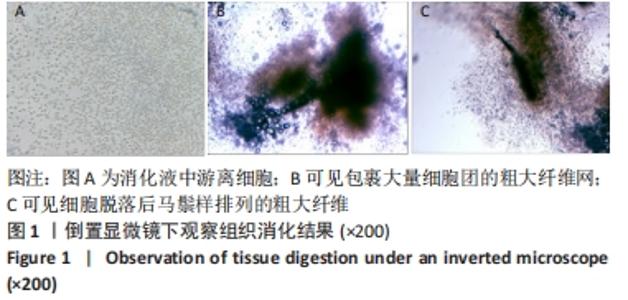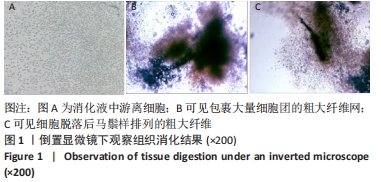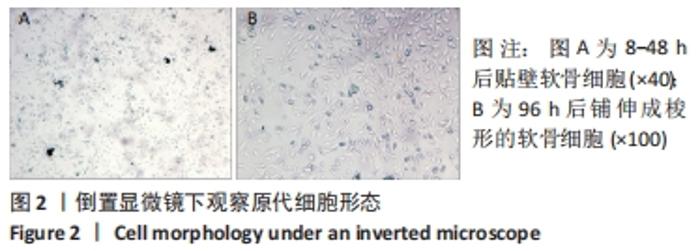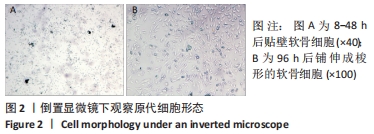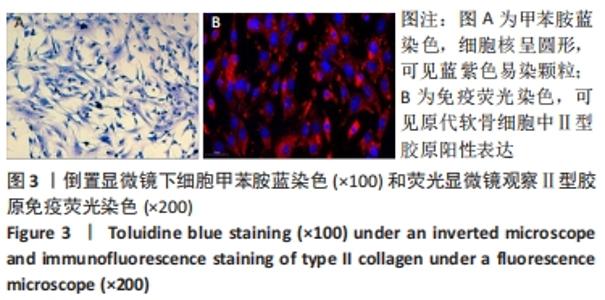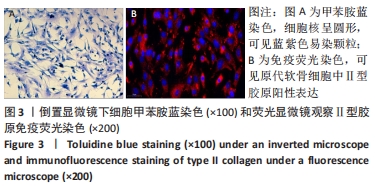Chinese Journal of Tissue Engineering Research ›› 2022, Vol. 26 ›› Issue (32): 5097-5101.doi: 10.12307/2022.909
Previous Articles Next Articles
In vitro isolation, culture and identification of chondrocytes from the ankle joint of aged mice
Jia Caixia1, 2, 3, He Si2, 3, 4, Ha Xiaoqin2, 3
- 1School of Public Health, Lanzhou University, Lanzhou 730000, Gansu Province, China; 2The 940th Hospital of Joint Logistics Support Force of PLA, Lanzhou 730050, Gansu Province, China; 3Key Laboratory of Stem Cell and Gene Medicine of Gansu Province, Lanzhou 730050, Gansu Province, China; 4The Second Clinical Medical College of Lanzhou University, Lanzhou 730000, Gansu Province, China
-
Received:2021-10-20Accepted:2021-12-10Online:2022-11-18Published:2022-05-12 -
Contact:Ha Xiaoqin, MD, Professor, Chief physician, The 940th Hospital of Joint Logistics Support Force of PLA, Lanzhou 730050, Gansu Province, China; Key Laboratory of Stem Cell and Gene Medicine of Gansu Province, Lanzhou 730050, Gansu Province, China -
About author:Jia Caixia, Master candidate, School of Public Health Lanzhou University, Lanzhou 730000, Gansu Province, China; The 940th Hospital of Joint Logistics Support Force of PLA, Lanzhou 730050, Gansu Province, China; Key Laboratory of Stem Cell and Gene Medicine of Gansu Province, Lanzhou 730050, Gansu Province, China -
Supported by:the Top-notch and Leading Talents in Gansu Province, No. 2020808 (to HXQ); the Fundamental Research Funds for the Central Universities, No. 31920200020 (to HXQ); Lanzhou Municipal Talent Training Innovation and Entrepreneurship Project, No. 2016-RC-61 (to HXQ)
CLC Number:
Cite this article
Jia Caixia, He Si, Ha Xiaoqin. In vitro isolation, culture and identification of chondrocytes from the ankle joint of aged mice[J]. Chinese Journal of Tissue Engineering Research, 2022, 26(32): 5097-5101.
share this article
Add to citation manager EndNote|Reference Manager|ProCite|BibTeX|RefWorks
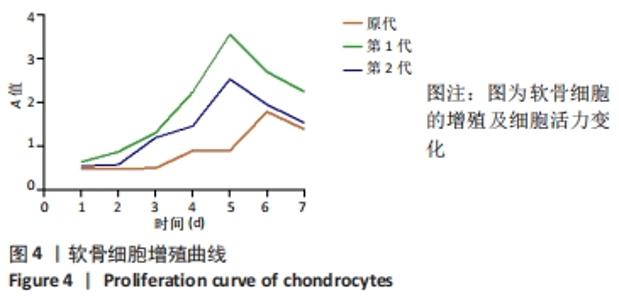
2.5 原代贴壁细胞培养液和消化液中硫酸糖胺多糖水平 硫酸糖胺多糖标准品标准曲线方程为y=0.139 2x+0.128 5 (R2=0.988 3);原代细胞培养液和消化液中硫酸糖胺多糖水平分别为(42.41±15.00),(65.63±10.00) mg/L;阴性对照中硫酸糖胺多糖水平分别为(0.35±3.78),(0.21±2.56) mg/L。 2.6 细胞增殖曲线 原代软骨细胞增殖较缓慢,前5 d时间里,细胞多呈梭形网状交织分布,第6天时,细胞数量可达最大,呈铺路石样铺满孔底。第1代和第2代软骨细胞增殖速度大致相同,细胞数量均在第5天达到最大,但在同一时间里,第1代软骨细胞的活力高于第2代软骨细胞,高于原代软骨细胞,见图4。"
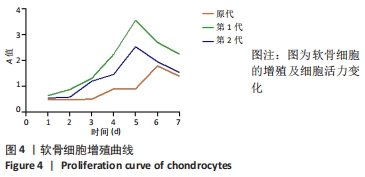
| [1] ZHANG Y, GUO WM, WANG MG, et al. Co-culture systems-based strategies for articular cartilage tissue engineering. J Cell Physiol. 2018;233(3):1940-1951. [2] WANG HR, ZHU ZH, WU JN, et al. Effect of type II diabetes-induced osteoarthritis on articular cartilage aging in rats: A study in vivo and in vitro.Exp Gerontol. 2021;150:111354. [3] LIAO YH, LONG JS T, GALLO CJR, et al. Isolation and Culture of Murine Primary Chondrocytes: Costal and Growth Plate Cartilage. Methods Mol Biol. 2021;2230:415-423. [4] WANG RK, JIANG W, ZHANG L, et al. Intra-articular delivery of extracellular vesicles secreted by chondrogenic progenitor cells from MRL/MpJ superhealer mice enhances articular cartilage repair in a mice injury model. Stem Cell Res Ther. 2020;11(1):1-14. [5] RUAN G, XU J, WANG K, et al. Associations between knee structural measures, circulating inflammatory factors and MMP13 in patients with knee osteoarthritis. Osteoarthritis Cartilage. 2018;26(8):1063-1069. [6] TAN SHARON SH, TJIO CKE, WONG JRY, et al. Mesenchymal Stem Cell Exosomes for Cartilage Regeneration: A Systematic Review of Preclinical In Vivo Studies. Tissue Eng Part B Rev. 2018;233(3):1940-1951. [7] KAROL J, ALINA J, BARBARA B. Cell cultures in drug discovery and development: The need of reliable in vitro-in vivo extrapolation for pharmacodynamics and pharmacokinetics assessment. J Pharm Biomed Anal. 2018;147:297-312. [8] LAVENDER C, SINAADIL SA, SINGH V, et al. Autograft Cartilage Transfer Augmented With Bone Marrow Concentrate and Allograft Cartilage Extracellular Matrix. Arthrosc Tech. 2020;9(2):e199-e203. [9] ALTMAN RD, MANJOO A, FIERLINGER A, et al. The mechanism of action for hyaluronic acid treatment in the osteoarthritic knee:a systematic review. BMC Musculoskeletal Disord. 2015;16:321. [10] CHANG KV, HUNG CY, ALIWARGA F, et al. Comparative effectiveness of platelet-rich plasma injections for treating knee joint cartilage degenerative pathology:a systematic review and meta- analysis. Arch Phys Med Rehabil. 2014;95(3):562- 575. [11] ZHOU QF, CAI YZH, JIANG YZ, et al. Exosomes in osteoarthritis and cartilage injury: advanced development and potential therapeutic strategies. Int J Biol Sci. 2020;16(11):1811-1820. [12] XIE F, LIU YL, CHEN XY, et al. Role of MicroRNA, LncRNA, and Exosomes in the Progression of Osteoarthritis: A Review of Recent Literature. Orthop Surg. 2020;12:708-716. [13] LI JS, DING ZY, LI YZ, et al. BMSCs-Derived Exosomes Ameliorate Pain Via Abrogation of Aberrant Nerve Invasion in Subchondral Bone in Lumbar Facet Joint Osteoarthritis. J Orthop Res. 2020;38(3):670-679. [14] ZHANG R, MA J, HAN J, et al. Mesenchymal stem cell related therapies for cartilage lesions and osteoarthritis. Am J Transl Res. 2019;11(10):6275-6289. [15] RYU JH, CHUN JS. Opposing roles of WNT-5A and WNT-11 in interleukin-1beta regulation of type II collagen expression in articular chondrocytes. J Biol Chem. 2006;281(31):22039-22047. [16] KOROSTYNSKI M, MALEK N, PIECHOTA M, et al. Cell-type-specific gene expression patterns in the knee cartilage in an osteoarthritis rat model. Funct Integr Genomics. 2018;18(1):79-87. [17] WATT FE. Osteoarthritis biomarkers: year in review. Osteoarthritis Cartilage. 2018;26(3):312-318. [18] MI B, LIU G, ZHOU W, et al. Identification of genes and pathways in the synovia of women with osteoarthritis by bioinformatics analysis. Mol Med Rep. 2018;17(3):4467-4473. [19] MOON SM, SA LE, HAN SH, et al. Aqueous extract of codium fragile alleviates osteoarthritis through the MAPK/NF-κB pathways in IL- 1β-induced rat primary chondrocytes and a rat osteoarthritis model. Biomed Pharmacother. 2018;97:264-270. [20] LI ZM, LI M. Improvement in orthopedic outcome score and reduction in IL-1β, CXCL13, and TNF-α in synovial fluid of osteoarthritis patients following arthroscopic knee surgery. Genet Mol Res. 2017;16(3):16039487. [21] WALY NE, REFAIY A, ABOREHAB NM. IL-10 and TGF-β: roles in chondroprotective effects of glucosamine in experimental osteoarthritis?. Pathophysiology. 2017;24(1):45-49. [22] BARRETO G, SENTURK B, COLOMBO L, et al. Lumican is upregulated in osteoarthritis and contributes to TLR4-induced pro-inflammatory activation of cartilage degradation and macrophage polarization. Osteoarthritis Cartilage. 2020;28(1):92-101. [23] MORELAND LW. Intra- articular hyaluronan (hyaluronic acid) and hylans for the treatment of osteoarthritis:mechanisms of action. Am J Transl Res. 2003;5(2):54-67. [24] 郑晓芬. 骨关节炎发病机制和治疗的最新进展[J]. 中国组织工程研究, 2017,21(20):3255- 3262. [25] HOSEIN PJ, MARAGULIA JC, SALZBERG MP, et al. A multicentre study of primary breast diffuse large B-cell lymphoma in the rituximab era. Br J Haematol. 2014;165(3):358-363. [26] ZHAO C, JIN YP, WEN M, et al. Exosomes from adipose-derived stem cells promote chondrogenesis and suppress inflammation by upregulating miR-145 and miR-221. Mol Med Rep. 2020;21(4):1881-1889. [27] GREEN WT. Behavior of articular chondrocytes in cell culture. Clin Orthop. 1971;75:248-260. [28] KLAGSBRUN M. Large- scale preparation of chondrocy tes. Methods Enzymol. 1979;58:560-564. [29] SHIMOMURA Y, YONEDA T, SUZUKI F. Osteogenesis by chondrocytes from grow th cartilage of rat rib. Calcif Tissue Res. 1975;19:179-187. [30] QI H, LIU DP, XIAO DW, et al. Exosomes derived from mesenchymal stem cells inhibit mitochondrial dysfunction-induced apoptosis of chondrocytes via p38, ERK, and Akt pathways. In Vitro Cell Dev Biol Anim. 2019;55(3): 203-210. [31] 魏钰, 魏民. 人骨关节炎软骨细胞的体外分离与培养[J]. 中国组织工程研究,2019,23(25):4056-4061. [32] 李文辉. 软骨组织工程种子细胞及其培养方法[J]. 中华创伤骨科杂志, 2003,5(3):90-92. [33] 杜国庆, 桑晓文, 王楠, 等. 大鼠半月板纤维软骨细胞的体外培养和生物学特征鉴定[J]. 现代生物医学进展,2019,19(15):2829-2833. [34] NIPHA C, PHONGSAKORN K, PARINYA N. Three-dimensional cell culture systems as an in vitro platform for cancer and stem cell modeling. World J Stem Cells. 2019;11(12):1065-1083. [35] 刘小荣,张笠,高武,等. 新西兰兔关节软骨细胞分离培养与鉴定的实验研究[J]. 国际检验医学杂志,2012,33(19):2307-2308. [36] RODRIGUES A, PAP S. The effect of long- term culture on the ability of human articular chondrocytes to generate tissue engineered cartilage// Stard GB, Horch R, Tanczos E (eds).Biologicalmatrices And tissue Reconstruction. 1998:163-168. [37] SCHIPHOF D, VAN DEN DRIEST JJ, RUNHAAR J. Osteoarthritis year in review 2017: rehabilitation and outcomes. Osteoarthritis Cartilage. 2018;26(3): 326-340. [38] DEHNE T, KARLSSON C, RINGE J, et al. Chondrogenic differentiation potential of osteoarthritic chondrocytes and their possible use in matrix-associated autologous chondrocyte transplantation. Arthritis Res Ther. 2009;11(5):R133. [39] HE P, ZHANG Z, LIAO W, et al. Screening of gene signatures for rheumatoid arthritis and osteoarthritis based on bioinformatics analysis. Mol Med Rep. 2016;14(2):1587-1593. [40] LIU Y, JING J, YU H, et al. Expression profiles of long non-coding RNAs in the cartilage of patients with knee osteoarthritis and normal individuals. Exp Ther Med. 2021;21(4):365-375. [41] GIBSON AL, HUI MC, FOOTE AT, et al. Wnt7a inhibits IL-1β induced catabolic gene expression and prevents articular cartilage damage in experimental osteoarthritis. Sci Rep. 2017;7:41823. |
| [1] | Sun Kexin, Zeng Jinshi, Li Jia, Jiang Haiyue, Liu Xia. Mechanical stimulation enhances matrix formation of three-dimensional bioprinted cartilage constructs [J]. Chinese Journal of Tissue Engineering Research, 2023, 27(在线): 1-7. |
| [2] | Du Xueting, Zhang Xiaodong, Chen Yanjun, Wang Mei, Chen Wubiao, Huang Wenhua. Application of compressed sensing technology in two-dimensional magnetic resonance imaging of the ankle joint [J]. Chinese Journal of Tissue Engineering Research, 2023, 27(9): 1396-1402. |
| [3] | Zhang Hui, Wang Jiayang, Wang Qian, Gan Hongquan, Wang Zhiqiang. Effects of hyaluronic acid combined with domestic porous tantalum on chondrocyte function under the dynamic environment [J]. Chinese Journal of Tissue Engineering Research, 2023, 27(3): 339-345. |
| [4] | Zhang Weiye, Zhan Jiawen, Zhu Liguo, Wang Shangquan, Chen Ming, Wei Xu, Feng Minshan, Yu Jie, Han Tao, Cai Chuhao, Zhou Shuaiqi, Shao Chenchen. Effect of nucleus pulposus cells-derived exosomes under cyclic mechanical tension on endplate chondrocytes [J]. Chinese Journal of Tissue Engineering Research, 2023, 27(2): 223-229. |
| [5] | Wang Huanhuan, Wang Qing, Tang Peng, Zhang Rui, Min Hongwei. Effects of extracorporeal shock wave on the proliferation and autophagy of chondrocytes from osteoarthritis rats [J]. Chinese Journal of Tissue Engineering Research, 2023, 27(2): 252-257. |
| [6] | Li Zhe, Yuan Changshen, Guan Yanbing, Xu Wenfei, Liao Shuning, Rong Weiming, Mei Qijie, Duan Kan. Bioinformatic analysis and experimental validation of ferroptosis in osteoarthritis [J]. Chinese Journal of Tissue Engineering Research, 2023, 27(17): 2637-2643. |
| [7] | Huang Haoran, Wei Yangwenxiang, Zhang Jiahao, Mo Liang, Liu Yuhao, Chen Zhenqiu, Wang Haibin, Zhou Chi. Piezo1-mediated mechanical stress stimulation in anti-osteoporosis treatment [J]. Chinese Journal of Tissue Engineering Research, 2023, 27(17): 2716-2722. |
| [8] | Yang Jun, Li Peng. Differentiation of bone marrow mesenchymal stem cells into meniscus fibrochondrocytes induced by transforming growth factor beta [J]. Chinese Journal of Tissue Engineering Research, 2023, 27(15): 2412-2419. |
| [9] | Liao Jianzhao, Yang Nan, Zhou Yi, Xu Hang, Xia Tian, Song Shilei, Zeng Qi, Chen Yueping. Protective effect of astragaloside IV against inflammatory injury in chondrocytes [J]. Chinese Journal of Tissue Engineering Research, 2023, 27(14): 2158-2163. |
| [10] | Bai Zixing, Cao Xuhan, Sun Chengyi, Yang Yanjun, Chen Si, Wen Jianmin, Lin Xinxiao, Sun Weidong. Construction and biomechanical analysis of ankle joint finite element model in gait cycle [J]. Chinese Journal of Tissue Engineering Research, 2022, 26(9): 1362-1366. |
| [11] | Wu Cong, Jia Quanzhong, Liu Lun. Relationship between transforming growth factor beta1 expression and chondrocyte migration in adult articular cartilage after fragmentation [J]. Chinese Journal of Tissue Engineering Research, 2022, 26(8): 1167-1172. |
| [12] | Shao Yangyang, Zhang Junxia, Jiang Meijiao, Liu Zelong, Gao Kun, Yu Shuhan. Kinematics characteristics of lower limb joints of young men running wearing knee pads [J]. Chinese Journal of Tissue Engineering Research, 2022, 26(6): 832-837. |
| [13] | Xu Kuishuai, Zhang Liang, Chen Jinli, Ren Zhongkai, Zhao Xia, Li Tianyu, Yu Tengbo. Effect of force line changes on lower limb joints after medial open wedge high tibial osteotomy [J]. Chinese Journal of Tissue Engineering Research, 2022, 26(6): 821-826. |
| [14] | Xu Lei, Han Xiaoqiang, Zhang Jintao, Sun Haibiao. Hyaluronic acid around articular chondrocytes: production, transformation and function characteristics [J]. Chinese Journal of Tissue Engineering Research, 2022, 26(5): 768-773. |
| [15] | Lin Xuchen, Zhu Hainian, Wang Zengshun, Qi Tengmin, Liu Limin, Suonan Angxiu. Effect of xanthohumol on inflammatory factors and articular cartilage in a mouse mode of osteoarthritis [J]. Chinese Journal of Tissue Engineering Research, 2022, 26(5): 676-681. |
| Viewed | ||||||
|
Full text |
|
|||||
|
Abstract |
|
|||||
